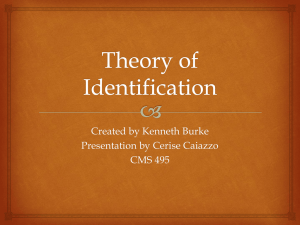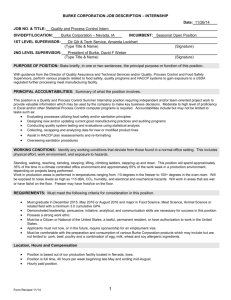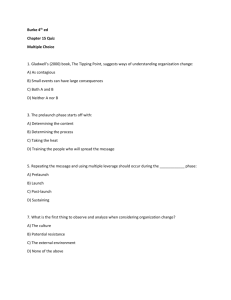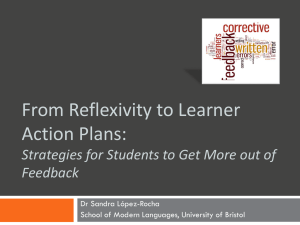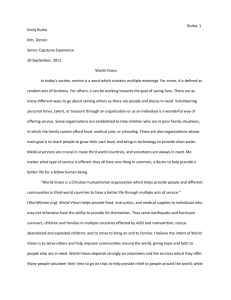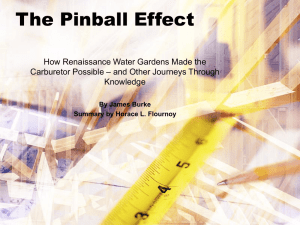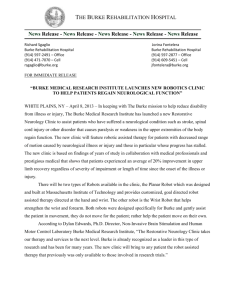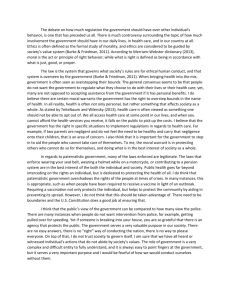English 505 Rhetorical Theory Session Fifteen Notes Goals
advertisement
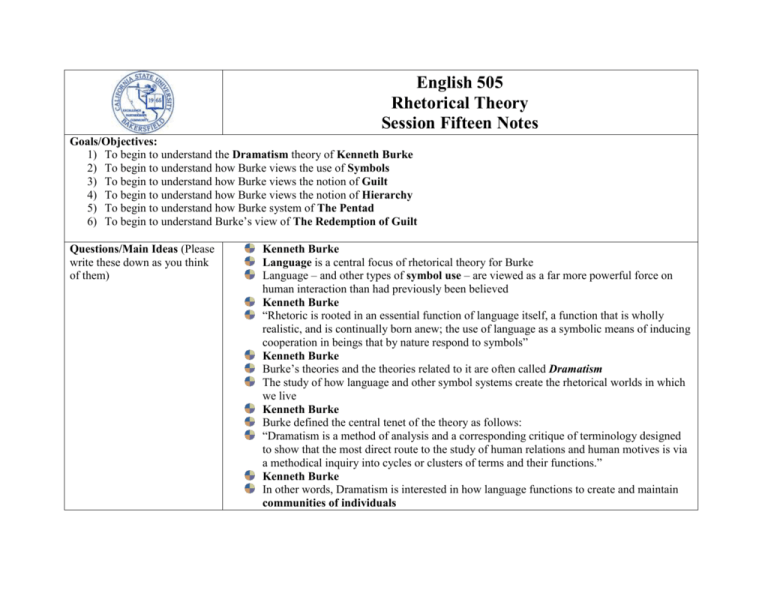
English 505 Rhetorical Theory Session Fifteen Notes Goals/Objectives: 1) To begin to understand the Dramatism theory of Kenneth Burke 2) To begin to understand how Burke views the use of Symbols 3) To begin to understand how Burke views the notion of Guilt 4) To begin to understand how Burke views the notion of Hierarchy 5) To begin to understand how Burke system of The Pentad 6) To begin to understand Burke’s view of The Redemption of Guilt Questions/Main Ideas (Please write these down as you think of them) Kenneth Burke Language is a central focus of rhetorical theory for Burke Language – and other types of symbol use – are viewed as a far more powerful force on human interaction than had previously been believed Kenneth Burke “Rhetoric is rooted in an essential function of language itself, a function that is wholly realistic, and is continually born anew; the use of language as a symbolic means of inducing cooperation in beings that by nature respond to symbols” Kenneth Burke Burke’s theories and the theories related to it are often called Dramatism The study of how language and other symbol systems create the rhetorical worlds in which we live Kenneth Burke Burke defined the central tenet of the theory as follows: “Dramatism is a method of analysis and a corresponding critique of terminology designed to show that the most direct route to the study of human relations and human motives is via a methodical inquiry into cycles or clusters of terms and their functions.” Kenneth Burke In other words, Dramatism is interested in how language functions to create and maintain communities of individuals The Nature of Rhetoric For Burke, the influence of language goes far beyond its persuasiveness Kenneth Burke He viewed rhetoric as creating realities in which we must operate He explained that we use rhetoric to navigate our way through those rhetorically created social structures and rules Kenneth Burke “And however important to us is the tiny sliver of reality each of us has experienced firsthand, the whole overall “picture” is but a construct of our symbol systems. To meditate on this fact until one sees its full implications is much like peering over the edge of things into an ultimate abyss. Kenneth Burke And doubtless that’s one reason why, though man is typically the symbol-using animal, he clings to a kind of naïve verbal realism that refuses to realize the full extent of the role played by symbolicity in his notions of reality.” Kenneth Burke For Burke, the essential difference between humans and animals is that humans have the capacity to create, use, and misuse symbols Kenneth Burke Happily, Burke provides us with the key for understanding his theory of Dramatism through his definition of humans (1966) He revised this several times, ultimately composing it in poetic form Kenneth Burke Being bodies that learn language thereby becoming wordlings humans are the symbol-making, symbol-using symbol-misusing animal Kenneth Burke inventor of the negative separated from our natural condition by instruments of our own making goaded by the spirit of hierarchy and rotten with perfection Kenneth Burke We begin to understand Burke, then, by understanding these parts Symbol Use Implicit in our symbol use is the concept of naming Kenneth Burke When we use symbols, we identify a person, place, object or event in such a way as to distinguish it from something else We can never be completely objective when we do this because language is not neutral Kenneth Burke Burke suggested that naming is a “magical act” that only approximates the relationship between the named and what it truly represents Burke explained that symbols are “screens” that separate us from a nonverbal world Kenneth Burke As a result, our names contain “attitudes” toward the objects of what we name These attitudes suggest our position toward the object as well as suggest how others should view the object Kenneth Burke Examples: various ideological positions in contemporary cultural debates: pro-life vs. pro-choice Each label suggests a way of looking at the issue Kenneth Burke Each label also suggests a way of viewing the other side: pro-death/anti-life vs. antichoice Therefore, given the capacity to use symbols, we also have the capacity to misuse symbols, and do so quite regularly Kenneth Burke Sexual harassment is an example It can occur solely through the use of symbols. Physical contact is not necessary Kenneth Burke We misuse symbols to exert power to unfairly manipulate circumstances in an illegitimate and unjust way Negative Symbols A particular type of symbol is the negative representing the idea of “no” or “not” Kenneth Burke The negative is inherent in symbol use Before we were able to use symbols, humans could only make gestures which couldn’t accommodate the idea of “no” Kenneth Burke As humans began to develop symbols to represent abstract objects, they also developed the idea of “no” or “not” Burke believed that the negative serves definitional and moral functions in rhetoric Kenneth Burke When we define things, we define them in terms of what they are not Our symbol use is marked by “the paradox of substance”: To say what something is, we have to say what it is not Kenneth Burke Thus, we can’t use symbols without implicitly referencing what the symbol is not At the same time, we must be careful to realize that the word is not the thing it names Kenneth Burke In addition to defining, the negative also serves a moral function The negative is then used to create moral rules for how we should act IOW, it allows us to say “thou shalt not” Kenneth Burke Burke stressed the idea that not only did humans invent the negative, but language and the negative “invented” us as well By this, he is referring to the moralizing aspect of the negative Kenneth Burke When we are invented by the negative, we become moral agents, capable of making choices about what we should and should not do Inevitably, Burke contends, we violate moral laws creating guilt Kenneth Burke Guilt Guilt is a sense of disorder, imbalance, or remorse that individuals and groups feel because of symbol use Guilt is experienced at different degrees or levels Kenneth Burke Individual guilt Forgetting to meet a friend Failing a test because you didn’t study long enough Cheating on a test Kenneth Burke Categorical guilt Experienced by groups of people When a child commits murder, many members in society feel guilt because such action is a sign that something is wrong with the social order Kenneth Burke When political leaders do something wrong, many members of society also feel guilt Thus, guilt is experienced by both individuals and groups Further ways that guilt is created through the use of rhetoric: Kenneth Burke Hierarchy Humans are “goaded by the spirit of hierarchy” Implicit in our symbol use is the idea of hierarchy Humans use words to arrange themselves in structures, organizations, and social orders Kenneth Burke Positions in government, for example, with all their rights and responsibilities, are created and perpetuated by our laws and customs, which depend on rhetoric Despite attempts to minimize differences between individuals . . . Kenneth Burke . . . guilt results when we operate in structures that allow privileges to some, but deny those same privileges to others Thus, hierarchy can be a source of guilt that results from rhetoric For example: Kenneth Burke A junior or a senior may feel guilt toward freshmen who can’t register for classes early and thus fail to be able to take the classes they wish (OK, maybe not the best example) Another concept implicit in hierarchy: mystery Kenneth Burke Mystery is part of the difference in status between them and us and in part preserves that distance For example: King and peasant are ‘mysteries’ to each other Or movie stars Kenneth Burke Also central to rhetoric is the desire by humans to seek perfection We seek to use “proper names” or we try to live the “perfect life” Burke pointed out that perfection, ironically, can be very destructive Kenneth Burke For example, an athlete may try to negotiate the perfect contract They are entitled to millions of dollars in compensation while the poorest members of society hunger Kenneth Burke The result of trying to live the perfect life often causes us, or our society, great suffering in the process Our pursuit of perfection, Burke claims, may result in a rotten society, which leads to members experiencing guilt Kenneth Burke Putting the elements to use Burke felt that by understanding these central elements of dramatism, one could use these elements to understand the nature and implications of rhetoric Kenneth Burke Burke distinguished between motion and action Motion is non-symbolic – growth of a tree Action is based on symbols, or rhetoric. – saying the word “tree” Kenneth Burke Postulates (that further describe the relationship): First – “there can be no action without motion” Speaking – a symbolic act, requires that you move your mouth and other physical features to make a word. Even thinking takes neurological motion Kenneth Burke Second – “there can be motion without action” A tree grows despite what we call it Third – “action is not reducible to terms of motion” Kenneth Burke Without understanding the meaning of the words, the physical representations of the letters on the page are meaningless Besides allowing us to communicate, action involves choice. A tree has no choice but to grow, but humans can choose to use symbols Kenneth Burke Because rhetoric provides the opportunity for humans to act, moral rules and laws exist to govern the choices we make Again, rhetoric leads to moral choices and consequently makes guilt a part of our social system Kenneth Burke Rhetoric also leads to identification: “A is not identical with his colleague B. But insofar as their interests are joined, A is identified with B. Or he may identify himself with B even when their interests are not joined, if he assumes that they are, or is persuaded to believe so.” Kenneth Burke When two individuals identify with each other, they are “consubstantial” This means that there is a degree of overlap between the individuals which can be real or perceived Kenneth Burke We use rhetoric to identify with a variety of “targets”, including other people, families, groups, values, goals, knowledge, activities, or objects Because of rhetoric, we experience division and conflict Kenneth Burke Consequently we seek to identify with others to overcome this division Hierarchy promotes the differences between people; so we use rhetoric to identify with them Kenneth Burke We identify with others to reduce the mystery Because we seek out identification, it follows that rhetors may also use rhetoric strategically to convince us that we are like them Kenneth Burke For example, a politician saying that they have shared experiences: “I feel your pain” Therefore, there is a fine line between cooperation and exploitation Kenneth Burke Ultimately, rhetoric, seen as the desire to identify with others, is a moralizing force in our culture Rhetoric as identification Identification is related to cooperation and highlights the role that audiences pay in persuasion Kenneth Burke Audience members persuade themselves to identify with the rhetor The concept also allows for the possibility for unconscious persuasion to occur as we persuade ourselves without being explicitly persuaded by others Kenneth Burke Burke concluded that we can be our own audiences and act upon messages of our “secret thoughts” The words of others are only effective, wrote Burke, when they can “speak in the language of a voice within” Kenneth Burke Persuasion is only complete when an audience member convinces himself or herself of what has been said by others Identification is achieved when rhetors use one or more of three broad types of identification Kenneth Burke The first type is obvious and direct – making the audience think that you are one of them Ex: the politician who, though now rich, tells of his humble beginnings Kenneth Burke The second type uses antithesis, creating an us-versus-them distinction IOW, a rhetor identifies a particular person, object, or situation as an enemy of the audience being addressed Kenneth Burke The third type “derives from situations in which it goes unnoticed” For example, using the word “we” to unite audience members with the rhetor is a powerful, yet subtle, type of identification Kenneth Burke Burke’s Pentad Burke was interested in the relationship between thought and words When we conceive of a situation, we communicate to others how we see that situation through the rhetoric we use Kenneth Burke The words we use are not neutral, objective references to objects or ideas. Instead, our rhetoric is always subjective; but at the same time, we cannot escape the rhetorical worlds we inhabit Kenneth Burke The strategies we use to frame situations are based on Motives or Situations “Situation,” wrote Burke, “is but another word for motives” The pentad is a tool of analysis that lets us trace how our worlds are constructed through rhetoric Kenneth Burke In so doing, we also understand the various motives, or situations, that determine how individual rhetors size up the situations they face Five terms comprise the pentad: act, scene, agent, agency and purpose Kenneth Burke Burke’s description: “In a rounded statement about motives, you must have some word that names the act (names what took place, in thought or deed), and another that names the scene (the background of the act, . . . Kenneth Burke . . . the situation in which it occurred); also, you must indicate what person or kind of person (agent) performed the act, what means or instruments he used (agency) and the purpose.” Kenneth Burke Because individuals have different philosophies about the world, they are predisposed toward featuring one or two pentadic terms when they use rhetoric Burke believed the act to be the central term of the pentad Kenneth Burke What is significant, however, is how the act is reinterpreted by how rhetors feature the other elements of the pentad The scene refers to the background of the act or the situation in which the act took place Kenneth Burke Rhetors who feature the scene see the world as relatively permanent and deterministic The situation is thought to control the actions of agents who feature scenes Kenneth Burke The agent is the person who performs the act Rhetors who feature the agent see people as rational and capable of making rational choices Agents have the power to overcome scenic elements that limit their choices or actions Kenneth Burke Agency refers to the means through which an action takes place People who feature agency in their rhetoric are pragmatic, they are concerned with how to accomplish particular acts Kenneth Burke Some rhetors feature purpose when they talk That is, rhetors sometimes focus on the reason for doing something Burke felt that the pentad should not be used descriptively to simply identify the various elements in rhetoric Kenneth Burke The pentad should be used, according to Burke, to interpret the motives of a particular rhetor In other words, rhetors can choose which pentadic terms to emphasize to influence the thinking of an audience Kenneth Burke For instance, an agent can be labeled as responsible for a particular act, or the act may be portrayed as stemming from a particular scene For example, if you agree to meet a friend at the library at a particular time to study Kenneth Burke But your friend fails to show (your friend fails to act, in other words) You can identify your friend – the agent – as responsible Or you can say that something in the scene – car trouble, for instance – is responsible Kenneth Burke The relationship between two pentadic terms is called a ratio The lack of balance between two terms of a ratio can help critics understand the relationship between the two terms One element of the pentad can be explained by another Kenneth Burke For example, in the previous scenario, there are two ratios discussed: act-agent (the agent explains the act) act-scene (the scene explains the act) Kenneth Burke A further example: proponents of a federal welfare system Often use a scene-agent ratio in their rhetoric to justify social welfare They argue that social structures and systems have led to the need for welfare Kenneth Burke Economic realities, business practices, and educational opportunities prevent some people from gaining the kind of employment they need to escape poverty Scene is the controlling term of the scene-agent ratio Kenneth Burke The scene constrains the actions of the agents (welfare recipients) The counter-ratio used by those who oppose welfare is the agent-act ratio That is, individuals are responsible for their own actions Kenneth Burke The government should not support individuals who do not achieve success in our economic system In this case, the agents, welfare recipients, control the act, earning enough money to support themselves Kenneth Burke Redemption from Guilt When we experience guilt, we are induced to seek the perfect redemption from the guilt As we seek redemption, we look for symbolic sacrifices Kenneth Burke When the guilt becomes significant enough, an individual rhetor or a community of rhetors seeks to remove that guilt Burke outlined the process through which guilt is created and removed Kenneth Burke Rhetoric leads to guilt, but rhetoric is also the way of removing guilt from the social system In order to remove guilt and restore order, some kind of redeemer is needed Kenneth Burke Two general strategies for purification may be used: mortification and scapegoating Mortification occurs when the guilty individual or group admits their guilt and asks for forgiveness Kenneth Burke The scapegoat is the ‘representative’ or ‘vessel’ of certain unwanted evils, the sacrificial animal upon whose back the burden of these evils is ritualistically loaded Kenneth Burke This step involves substitution: one character may be redeemed through the act or agency of another We try to create a worthy or ‘perfect’ scapegoat Kenneth Burke A less than perfect scapegoat will not suffice Scapegoats can be made worthy in three ways: 1] Held legally responsible and subject to laws. (Enron) Kenneth Burke 2] Can be assigned in a fatalistic sense, has a flaw (Oedipus) 3] By being too good for this world (Jesus) Kenneth Burke An interesting example comes from Carlson & Hocking (1988) They examined the letters, notes, and other messages left by visitors at the Vietnam Veterans Memorial Kenneth Burke Sought to understand how visitors achieved redemption from their guilt caused by the Vietnam War Obviously, supposes that Americans feel guilt “about American involvement, the disastrous outcome and the lives lost” Kenneth Burke Visitors redefined the war’s victims as “sacrificial victims who died for our sins” (scapegoats) The fallen are heroic, cleansing the nation of the sins of the war Redemption is achieved through scapegoating Kenneth Burke The visitor transforms the war into “a positive event of heroism and bravery” For other visitors, the wall calls on them to come to terms with their own actions during the war or their own feelings about the war Kenneth Burke The messages these visitors leave behind illustrate that they are seeking penance as part of a mortification process Visiting the wall and responding to it are ways of apologizing to those who died Kenneth Burke Redemption is achieved in this case because the visitor can leave with a sense of peace because his or her guilt about the war has been reduced by paying respects to the fallen Kenneth Burke The alternative way of dealing with guilt is comedy Comic redemption holds that all individuals, at times, are guilty of foolish actions Instead of removing them from the social order Kenneth Burke Comic redemption is achieved by belittling the fool (Lucy, you got some ‘splainin to do), welcoming the fool back into the community, and learning from the foolish action Kenneth Burke The comic frame identifies social ills as arising from human error, not evil, and thus uses reason to correct them The result is that the social order learns from the mistakes of its members Kenneth Burke The three stages of comic enlightenment are: Incongruity – rhetors pursuing the comic route focus on the mistakes of a fool in the rhetorical community Kenneth Burke Belittling – comic belittling pokes fun at the comic scapegoat, teaching him or her a valuable lesson from which all in the community can learn Enlightenment – the end result is that all can learn from our mistakes Summary/Minute Paper:
